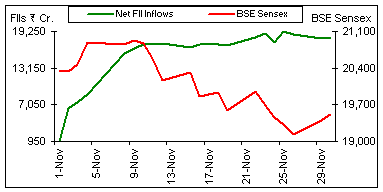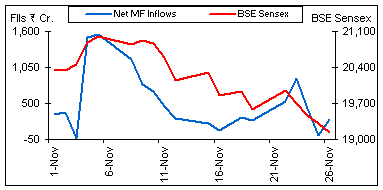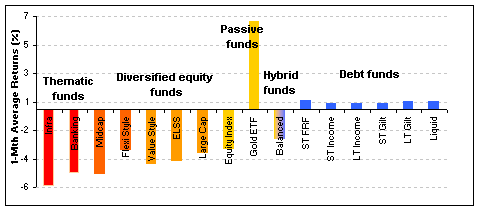Market Overview
Breaching its upwards bias as depicted in the last couple of months, the Indian equity markets (BSE Sensex) in the month of November 2010, felt the shivers of burgeoning debt crisis in Ireland, and ended the month down by 511.1 points (or -2.6%). The Indian equity markets also got nervous due to the 2G spectrum scam, which caused some damage to the telecom sector. The real estate sector too was upset due to “Adarsh” and housing loan scam; which exposed some big names such as LIC Housing Finance, Central Bank of India, Bank of India, Punjab National Bank and Money Matters Financial Services Ltd. These scams created both economic as well as political uncertainty, as some bigwigs from the corporate and political sphere were also forced to submit their resignations. Meanwhile, the opposition parties also demanded a JPC (Joint Parliamentary Committee) to be set up on the 2G spectrum issue.
Moreover, the IIP number of 4.4% for September 2010 (data released in November 2010) acted as a spoil sport for the market.
But as these economic and political uncertainties emerged, the precious yellow metal - gold became bold, as investors preferred to take refuge under this safe haven. The physical buying in the precious yellow metal on account of the forthcoming marriage season also fuelled the upward movement of gold, as stockist (gold merchants) amplified their stock levels.
Crude oil prices also climbed up by 4.3% as, the demand from most oil consuming nations rose as the stimulus package continued in most such nations.
The 10-Yr G-Sec yield softened by 7 basis points, as the Reserve Bank of India (RBI) increased the policy rates by 25 basis points, both on the repo (repo rate now at 6.25%) as well as the reverse repo rate (reverse repo rate now at 5.25%), as a measure to tame uncomfortable inflation level of 8.62% in September 2010. However, the tight liquidity situation caused by flooding of IPOs, FPOs NCDs, Bonds and Long-term Infrastructure Bonds kept the 10-Yr G-Sec yield, above the 8.00% mark.
Monthly Market Roundup
|
As on Nov 30, 2010 |
As on Oct 31, 2010 |
Change |
% Change |
| BSE Sensex |
19,521.3 |
20,032.3 |
(511.1) |
-2.6% ![]() |
| CNX Midcap |
8,907.5 |
9,360.7 |
(453.2) |
-4.8%  |
| Re/US $ |
45.9 |
44.4 |
(1.5) |
-3.3%![]() |
| 10-Yr G-Sec (%) |
8.06 |
8.13 |
(0.07) |
7 bps <img alt="" https:="" data.personalfn.com="" images="" down.gif"="" width="11" height="10"> |
| 1-Yr FDs |
6.50% - 7.50% |
(Monthly change as on November 30, 2010)
The graph hereunder clearly depicts that despite uncertainties on the economic as well as the political front; the FIIs continued to exude confidence in the Indian equity markets. In fact at every correction of the Indian equity markets, the FIIs bought more thus betting on the robust long-term economic outlook. FIIs bought worth  18,293 crore in the Indian equity markets in November 2010, as compared
18,293 crore in the Indian equity markets in November 2010, as compared  28,563 (net buying) in October 2010. They ignored the intermediate slow-down in the IIP number for September 2010 (data released in November 2010).
28,563 (net buying) in October 2010. They ignored the intermediate slow-down in the IIP number for September 2010 (data released in November 2010).
BSE Sensex vs FII inflows

(Source: ACE MF , PersonalFN Research)
Since the last two consecutive months, the IIP (Index of Industrial Production) numbers have fallen (from the high of 15.0% registered in June 2010); and now for the month of September 2010 it is 4.4%.
According to the quick estimates released by the Central Statistical Organisation (CSO), the main reason for such a nose dive in the IIP growth was on account of:
- Decelerating manufacturing growth - The manufacturing index, which is the principal component of the IIP, mellowed down to 4.5% from 7.5% in August 2010.
- Poor sectoral performance- The capital goods index once again took the maximum beating by registering a negative growth of -4.2% (in the previous month it was 2.1%). However, the consumer durables registered a growth of 10.9% (in the previous month it was 8.5%) while consumer non-durables grew at 2.5% (in the previous month it was 0.8%).
- Core sector growth - The core sector which has a weight of 26.68% to the IIP, and comprises of six key infrastructure industries - crude oil, petroleum refining, coal, electricity, cement and finished steel, also took a blip. It dropped to 2.5% from 3.7% registered in the previous month on account of decline in refining of petroleum products and coal production.
Reacting to the IIP numbers, the Finance Minister Mr. Pranab Mukherjee said, "Overall, the numbers are okay, but two consecutive months, it has come down. We will have to analyse why it is happening. After that, considered comments can be made. But it is a matter of concern."
In our opinion the nose dive in the IIP growth rate was due to the higher base effect of last year (September 2009), along with dampness in the core sector growth.
Mutual Fund Overview
Contrary to FII activity, the domestic equity mutual funds sailed along with the direction of the Indian equity markets. So, when the markets were rising they bought aggressively, but when the markets corrected they turned cautious buyers. Moreover, as the Indian equity markets showed signs of correction, investors also logged in redemption application in funds, in order to preclude wealth erosion.
In November 2010 mutual funds bought to the tune of  251 (net) in the Indian equity markets, which was contrary to the net selling of
251 (net) in the Indian equity markets, which was contrary to the net selling of  5,790 as displayed in the month of October 2010.
5,790 as displayed in the month of October 2010.
BSE Sensex vs MF inflows

(Source: ACE MF, PersonalFN Research)
As the Indian equity markets, shivered due to the economic and political factors as seen above, most Diversified equity funds and balanced funds (equity oriented), unlike the last month delivered negative returns. But pharma (as the sector being defensive), and technology (due to strengthening of dollar) funds gave some appealing positive returns.
Monthly top gainers: Open-ended equity funds
| Diversified Equity Funds |
1-Mth |
Balanced Funds |
1-Mth |
Sector Funds |
1-Mth |
| Axis Triple Adv (G) |
0.76% |
Baroda Pioneer Balance (G) |
-0.41% |
UTI Pharma & Healthcare (G) |
3.75% |
| UTI Wealth Builder-II (G) |
-0.20% |
FT India Balanced(G) |
-0.76% |
ICICI Pru Technology (G) |
3.34% |
| Sundaram Growth Fund (G) |
-0.29% |
Tata Balanced(G) |
-1.04% |
SBI Magnum Pharma (G) |
2.35% |
(1-Mth returns as on November 30, 2010)
(Source: ACE MF)
Monthly top gainers: Open-ended debt funds
| Monthly Income Plans |
1-Mth |
Long-Term Floating Rate Funds |
1-Mth |
Liquid Funds |
1-Mth |
| DWS Money Plus Advt-Reg (G) |
1.3% |
Birla SL FRF-LT (G) |
0.6% |
Escorts Liquid Plan (G) |
0.9% |
| DSPBR Savings Mgr-Agg (G) |
0.6% |
SBI Magnum FRF-LTP (G) |
0.6% |
Religare Overnight (G) |
0.7% |
| DWS Twin Advantage (G) |
0.6% |
HDFC FRF-LT (G) |
0.6% |
Pramerica Liquid Fund-Reg (G) |
0.6% |
(1-Mth returns as on November 30, 2010)
(Source: ACE MF)
Unlike equities, in debt instruments domestic mutual funds bought aggressively to the tune of  15,262 crore, thus continuing a similar trait of last month where they were net buyers to the tune of
15,262 crore, thus continuing a similar trait of last month where they were net buyers to the tune of  10,770 crore. This buying was due the increased confidence in the bond markets as the RBI increased the policy rates (both repo as well as the reverse repo rate) by 25 basis points, in an attempt to tame inflation which is yet above comfort level. In effect to the same debt mutual funds among the monthly income plans, floating rate plans and liquid plans too generated positive returns.
10,770 crore. This buying was due the increased confidence in the bond markets as the RBI increased the policy rates (both repo as well as the reverse repo rate) by 25 basis points, in an attempt to tame inflation which is yet above comfort level. In effect to the same debt mutual funds among the monthly income plans, floating rate plans and liquid plans too generated positive returns.
Performance across various categories of mutual funds

(Source: ACE MF, PersonalFN Research)
(1-Mth average returns of funds in various categories as on November 30, 2010)
As per the above graph, as the equity markets continued to shiver due to the global and domestic factors, thematic as well as diversified equity funds, including those following the index generated negative returns; and equity oriented hybrid funds followed the same trend. But with the RBI stepping to tame inflation, debt funds across all categories ended the month in positive terrain.
Other News and New Fund Offers
- Backed by spending on infrastructure such as roads and airports which will sustain economic growth, the BSE Sensex is on its course to double in the next 5 years according to Christopher Wood, Chief Strategist at CLSA.
According to the Planning Commission of India, in order to narrow the gap with China, India needs $1 trillion of investment in infrastructure including roads and ports between 2012 and 2017; which is double the estimated spending in the previous five years.
- The commission structures for selling equity mutual fund (MF) schemes are back on the high levels as those witnessed during the pre-entry load ban regime. With the equity markets buoyant, mutual fund houses are now offering more commissions to their distributors in order to survive in the market.
For instance, for a three-year monthly SIP of 10,000, upfront commission of 8,000 is given, which is equivalent to 2.25% of total investment. For five-year SIPs, it goes up to 22,000 or 3.75% of investment committed
- Considering the fact that understanding mutual schemes has become complex for average investors, the capital market regulator - The Securities and Exchange Board of India (SEBI) stepped in asked several Asset Management Companies (AMCs) to rework on some of the proposed new schemes and file offer documents afresh.
At present more than a dozen New Fund Offerings (NFOs) of leading AMCs such as Reliance, ICICI Prudential, Birla Sunlife, Kotak, Tata and Benchmark Asset Management are awaiting SEBI approval.
- The Organisation for Economic Cooperation and Development (OECD) has raised India's GDP (Gross Domestic Product) growth for the current fiscal to 9.1% from 8.3% earlier on the back of a strong rebound in the agricultural sector.
However, the OECD growth forecast should not be confused with Government of India's (GoI) projections for this fiscal at 8.5%, since the methodologies differ. While GoI calculates GDP by excluding indirect taxes, OECD includes these taxes for its calculation of GDP.
- The recent bond issue by State Bank of India (SBI) from October 18, 2010 - October 25, 2010 at a yield of 9.25% for 10 years and 9.5% for 15 years has turned out to be profitable for investors as the yields have now fallen below 9%.
The yield on the bond and price of the bond share an inverse relationship between each other. Hence, the price of the bond increases when the yield of the bond falls, which makes it profitable for the investors.
- SEBI asked Asset Management Companies (AMCs) to avoid exposure to real estate debt in certain schemes. SEBI directed AMCs to mention a 'negative sector list' in their draft prospectus, and give an undertaking that they will not invest in sectors that appear in this list.
- Amidst wave of changes affecting the mutual fund industry in terms of growth, AUM (Assets Under Management) size and distribution network; some of the leading mutual fund (MF) houses such as Reliance, UTI, Birla Sun Life, Tata, DSP Blackrock, AIG, Fidelity and Religare are adopting a smart strategy by signing up with the National Stock Exchange (NSE), to sell systematic investment plans (SIP) on NSE's online platform. This move came in as an attempt to overcome distributors' reluctance to sell mutual fund schemes as they (distributors) no longer find it lucrative enough, to sell mutual fund schemes due to the present miniscule commissions offered by mutual fund houses.
- Citing frequent changes in the expense ratio by various mutual fund (MF) houses, SEBI is planning to charge a flat expense fee of 1.5% for equity schemes, 1% for debt schemes and 0.75% for index funds.
Reacting to this a Chief Executive Officer (CEO) of leading fund house said, "MFs are already reeling under higher redemptions from equity schemes, after the entry load ban. The lowering of expense caps could be the final nail in the coffin for us."
- Birla Sun Life Mutual Fund (BSMF) launched a mobile platform called Mobile Investment Manager in association with MCHEK India Payment Systems (mChek). Existing investors of BSMF can seek portfolio information, make additional purchases, register for SIPs and also make switches and redemptions.
- In order to create awareness amongst investor community and impart education, SEBI wants MF to invest a part of their profits in building ties with the investors, rather than giving high commissions and freebies to agents.
This appeal by SEBI to the MFs comes on account of SEBI's concern over large-scale outflow of funds from mutual fund schemes.
- SEBI directed that the broker / clearing members would be responsible for sale and redemption of units being bought by investors from the secondary market. This is perceived as a big relief to the Asset Management Companies (AMC).
SEBI in its directive said, "Payment of redemption proceeds to the broker/clearing members by MF/AMC shall discharge MF/AMC of its obligation of payment to individual investor. Similarly, in case of purchase of units, crediting units into broker/clearing member pool account shall discharge MF/AMC of its obligation to allot units to individual investor."
Add Comments